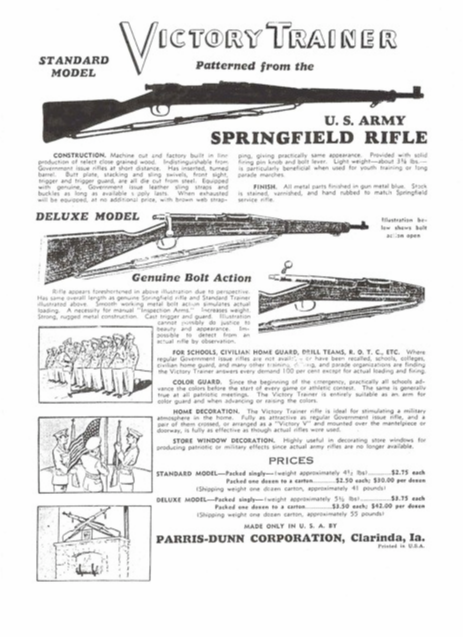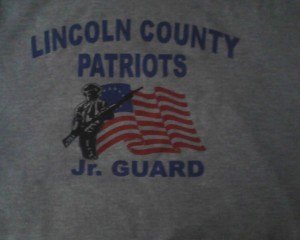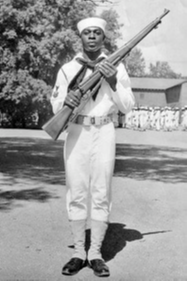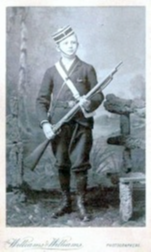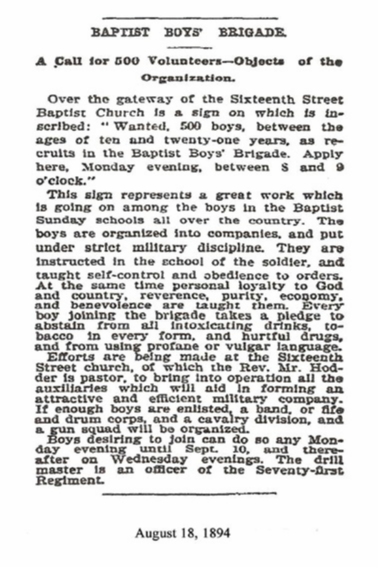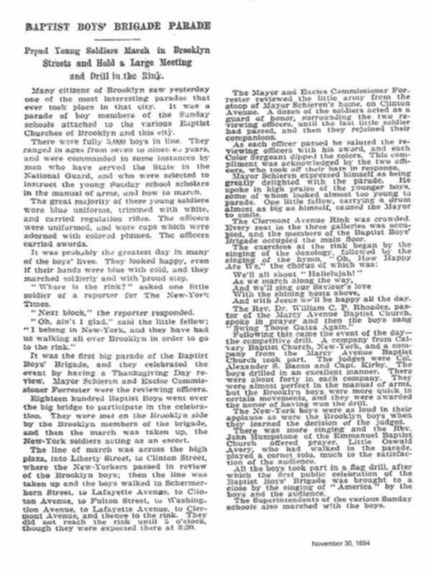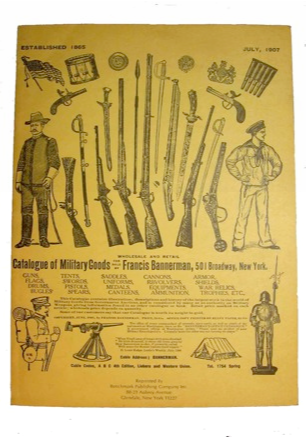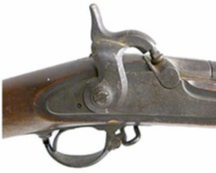PARRIS-DUNN CORP. – CIVILIAN DRILL RIFLES

Following the completion of their military contracts for the Parris-Dunn Training Rifle in 1943, they continued making a similar model for the civilian market. In 1949, William Dunn retired and sold the company to Cecil Parris. Parris renamed the company the Parris Manufacturing Company and continued to produce toy guns and drill rifles in Clarinda until 1951. In 1952, he moved the company to Savannah, Tennessee. The company is still located in Savannah and continues to produce a variety of toys.
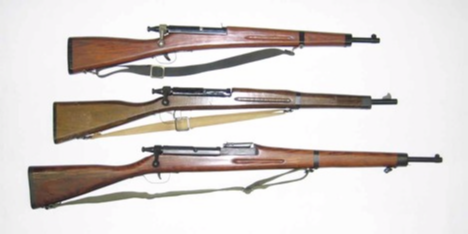
The earliest information concerning the civilian production of Parris-Dunn Corp. drill rifles is a flier showing what they called the Victory Trainer. This came in a Standard and Deluxe model. The Standard model has a fixed wooden bolt, a simplified trigger and a raised wooden platform for a rear sight. It was the same size and shape as the Parris-Dunn Training Rifle. The Deluxe model appears to be identical to their military contract Training Rifle. Both of these models have a metal butt plate marked:
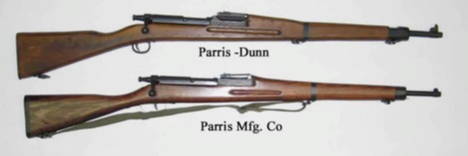
In March of 1946 the Parris-Dunn Corp. celebrated the production of their 2 millionth gun. This number included (335,000) military contract training rifles, (200,000) similar civilian models, and (1,465,000) drill rifles and other assorted toy guns. Mr. Greiman indicates that they had production capabilities to produce over 3000 guns a day.

Parris-Dunn TraineRifle
This specimen is the only Parris-Dunn marked toy TraineRifle that I have located that is the same general size and shape as the military models. It appears to be a composite of features taken from both of the military models. It has traces of the original Parris-Dunn decal remaining on the right side of the stock. The stock has the identical profile and thickness of the Victory 1942 Army model. The radius of the curved surfaces on the top and bottom of the stock is slightly greater than the Army model and is more similar to the Navy model. This tends to make the sides of the stock to look more flat. The finger groove on the fore arm is 7-1/2″ long as compared to 6-1/2″ on the military models. The front and middle bands are painted on the stock, the barrel is made of wood and there is no bayonet lug which are all features found on the Army model. The wooden barrel on the TraineRifle is 3-5/8″ long as compared to a 3-1/4″ length on the military models. The swivels, receiver and bolt are identical to the military models. The trigger, trigger guard and adjustable rear sight are identical in appearance and function to the Navy model. The butt plate is the same size and shape as the Navy model but has different markings. This marking is also found on the Standard and Deluxe models of the Victory Trainer which were made for civilian drill groups following the completion of the military contracts in 1943. I would guess that this TraineRifle was produced between 1945 and 1948. It appear that Parris-Dunn was attempting to use up the parts that were remaining from their military contracts and decided to add a full size TraineRifle to their toy line. It is interesting to note that this size TraineRifle never appears in any of the Parris-Dunn advertising but surfaces in the Parris Mfg. Co. advertising in 1955-56.
Parris Mfg. Co. M-30 TraineRifle
This toy bolt action training rifle was made by the Parris Mfg. Co. It was part of a line of toy rifles that they produced after the company moved from Clarinda, Iowa to Savannah, Tenn. It was the largest in the line and was probably developed primarily for use by the Kadets of America drill teams. It has many of the same characteristics of the earlier Parris-Dunn TraineRifle. The following illustration shows their similarity.

There is a significant difference in the weight and quality of the materials. The stock is made of pine and stained to look like walnut. The front and middle bands are painted black on the wood surface and there is no recess in the top of the front band. There is no metal butt plate. The face and a strip around the butt are painted black. The barrel is a thin metal tube also painted black. The trigger assembly and trigger guard are made of thin sheet metal. The trigger makes a clicking sound when pulled. This is accomplished by snapping a lever over a thin wooden strip. The stacking and sling swivels are very similar to those on the original military training rifles. This model was designed to carry a rubber bayonet and has a thin metal strip attached to the under side of the barrel to hold the bayonet in place.

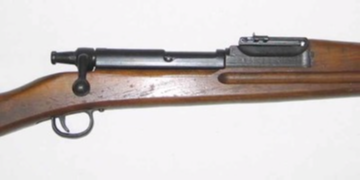
One unusual detail is the adjustable rear sight. This sight appears to be identical in material and workmanship to those used on the military contract training rifles. I am certain that every attempt was made to reduce the production costs of these TraineRifles. Most of the TraineRifle production had a decal on the side of the stock. Even when a decal was not applied or has worn off, they are easily identified as being very different from those produced by Parris-Dunn. They were produced from 1955-56 until at least 1970. The current M-30 model that they produce is a much simplified and a slightly shorter version but it retains the familiar bolt action.
The next installment: Toy Drill Rifles
From the paper, Non-Firing Drill and Training Rifles, by By Malcolm MacPherson

